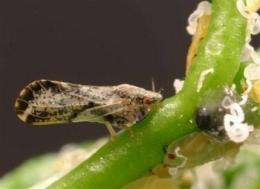Dangerous citrus pest found in California

(AP) -- A pest that can carry a fatal citrus disease has been found in Los Angeles County, stoking fears that California's $1.6 billion citrus industry could be hit by a potentially devastating threat.
Officials at the California Department of Food and Agriculture confirmed this week they found an Asian citrus psyllid in a trap in a homeowner's citrus tree in the Echo Park neighborhood, farther north in the state than ever before.
The discovery came shortly after officials confirmed the aphid-like insect had been found in Orange County. It had been confined to the state's southernmost San Diego and Imperial counties.
"This pest can travel, and it can do so quickly and easily," said Ted Batkin, president of the California-based Citrus Research Board.
He has called the pest and the vicious disease it can carry the greatest threat in the citrus industry's modern history.
Psyllids in Orange County tested negative for huanglongbing, also known as citrus greening disease, which spoils the flavor of the fruit and ultimately kills the tree. But fears are swirling that California could face the same fate as Florida, where the psyllid was first detected in 1998 and citrus greening was discovered in 2005.
Since then, CDFA said, the disease has spread to all the state's 30 citrus-producing counties and is laying waste to Florida's $9.3 billion citrus industry, which is largely based on orange juice production.
The pest has not yet reached California's central valley, where about three-fourths of the state's citrus production takes place. But Batkin worries the psyllid will close in on L.A. County's northern neighbor, Ventura County.
"We're about as concerned as we can be," Batkin said.
Ventura County is a center for orange and lemon growing and home to Santa Paula, a city that calls itself the Citrus Capital of the World and hosted its 42nd annual citrus festival in July.
Steve Lyle, spokesman for the CDFA, said the agency plans to continue its trapping efforts and will impose quarantines in at least parts of Orange and Los Angeles counties. During a quarantine, officials restrict the movement of plant materials out of the quarantine zone.
"We're doing all we can to pinpoint the full extent of the problem and protect our state's vital citrus industry," CDFA Secretary A.G. Kawamura said in a statement.
---
BISMARCK, N.D. (AP) - About 2 million acres of North Dakota cropland - or roughly 10 percent - did not get planted this year because of flooding caused by spring snowmelt and heavy rains, according to federal Farm Service Agency estimates.
The agency that administers federal farm programs says 2 million acres of unseeded land would be the third-highest amount in state records that go back 15 years, behind 3.9 million acres in 1999 and 2.1 million in 2001.
The number of unplanted acres is too small to affect crop prices nationwide and likely has already been factored into government production estimates based on farmer surveys closely watched by the commodity markets.
But 2 million acres would be a big blow to farmers in North Dakota and the state's economy.
"It's the difference between having a crop to sell at market vs. a smaller payment on your ... crop insurance," said Aaron Krauter, state FSA director. "Every producer out there, they want a crop to sell."
George Balsdon has been farming near Osnabrock in that county since the 1940s.
"This is the wettest I've ever seen," said Balsdon, 77. He and his sons were able to seed only about half of their 8,000 acres of wheat and canola last spring. "We just got going (with planting) and we got a 3-inch rain. Then we just got going again and we got a 2-inch rain.
"We didn't get half the farm in," he said. "A lot of neighbors didn't get anything in."
The FSA estimates show corn took the biggest hit from flooding in North Dakota, with about 588,000 acres going unseeded, followed by wheat with 488,000 acres unplanted and soybeans with 355,000 unseeded acres.
©2009 The Associated Press. All rights reserved. This material may not be published, broadcast, rewritten or redistributed.


















